 |
|

|
|

|
 |
TABLE of CONTENTS
 |
Lt. Gov. Smith, Commissioner Zelle join District 6 bridge inspection team in Rochester |
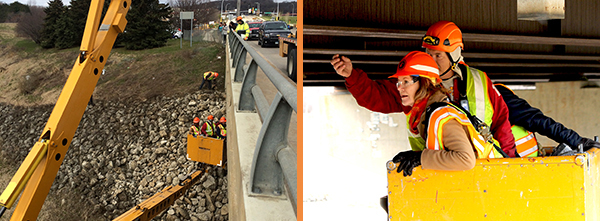
Lt. Gov. Tina Smith and Commissioner Charlie Zelle joined MnDOT bridge inspector Gary Waletzki April 11 for a view of the 16th Street SW Bridge in Rochester. At a news conference after the event, Lt. Gov. Smith spoke about the importance of ongoing investments in transportation infrastructure. Photo credits: Mike Dougherty (left), Kevin Gutknecht (right) |
Lt. Gov. Tina Smith and Commissioner Charlie Zelle joined a District 6 bridge inspection team April 11 in Rochester to help highlight the importance of ongoing investments in transportation infrastructure.
“Bridge inspections serve two important functions. They assure safety of our bridges and transportation system, and they provide solid data for bridge investment decisions on repairs and replacements,” Zelle said. “Bridge inspection and bridge maintenance are relatively small investments in our transportation infrastructure, but they help us achieve the maximum service life of our bridges while keeping the system safe.”
As part of the inspection of the 16th Street SW Bridge in Rochester, the lieutenant governor and the commissioner climbed into a snooper truck with MnDOT bridge inspector Gary Waletzki. The truck has a multi-jointed arm with a basket on the end to hold inspectors, who can maneuver the basket over, under and around a bridge to review it from all angles.
Statewide, MnDOT keeps a watchful eye on 20,501 state and local bridges, inspecting several thousand bridges annually. Every bridge in the state is inspected at least every two years, and some are inspected annually, depending on age and condition.
MnDOT also provides the expertise and equipment to inspect a large number of bridges for cities and counties, such as the 16th Street SW Bridge in Rochester, to ensure safety, as well as to guide plans for maintenance and replacement.
Even with thorough maintenance and monitoring, bridges typically last approximately 50 years. Once a bridge reaches its expected lifetime, maintenance and monitoring become more expensive and intensive. By 2025, it’s estimated that 850 bridges across Minnesota will need significant repair or require complete replacement.
This legislative session, Gov. Mark Dayton and Lt. Gov. Smith have proposed a transportation solution that would repair or replace 330 state-owned bridges statewide and would provide communities across Minnesota with additional resources for local bridge repair and replacement.
“More than 50 percent our roads are more than 50-years-old, while more than 40 percent of bridges are 40-years-old. Sustainable, comprehensive investments are essential to the long-term vitality and safety our transportation systems,” Smith said. |
 |
|

|
 |
TABLE of CONTENTS
 |
Agency leadership gathers to set draft highway investment direction for 2018-2037
|
|
By Philip Schaffner, Office of Transportation System Management
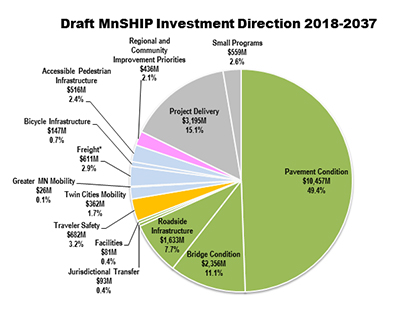
The draft investment direction focuses on maintaining the existing highway system, but does provide some funding to improve safety and mobility. Consistent with MAP-21 and the new FAST Act, the direction also prioritizes preservation of National Highway System routes. |
More than 60 key agency leaders representing all districts, central office and functional areas met March 22-23 to discuss priorities for future trunk highway capital investment. The meeting followed eight months of technical analysis and extensive public and stakeholder outreach as part of a required update to the Minnesota 20-Year State Highway Investment Plan or MnSHIP.
The decisions were anything but easy. With projected revenue of $21 billion and estimated needs of at least $36 billion, tradeoffs had to be considered.
Before evaluating how to allocate the projected revenue between 14 different investment categories, the group reviewed federal and state requirements, performance outcomes, environmental justice considerations, direction from the Statewide Multimodal Transportation Plan, key trends and input from the public and stakeholders.
Based on the recommendation from the meeting, the Transportation Program Investment Committee adopted a draft investment direction on April 5. The direction will not be finalized until MnSHIP is adopted in January 2017.
Despite allocating almost 70 percent of funds to asset management, the condition of the highway system is projected to get substantially worse over the 20 years covered by the plan.
Projected condition of highway system in 20 years |
Selected Infrastructure Categories
|
Current Condition
|
Projected Condition in 2037
|
Interstate pavement |
1.9% poor |
4.5% poor |
Remaining NHS pavement |
2.9% poor |
10-11% poor |
Non-NHS Pavement |
4.0% poor |
17-18% poor |
NHS bridges |
4.5% poor |
5% poor |
Non-NHS bridges |
1.3% poor |
7-8% poor |
Culverts |
10% poor |
14-15% poor |
|

“Like the current MnSHIP, this draft investment direction represents our best effort to choose between outcomes that no one likes. Without a major increase in revenue, we are going to see a significant deterioration of our highway system,” said Mark Nelson, Planning and Data Analysis manager in the Office of Transportation System Management. “We are also not going to be able to make the investments to address reliability, freight and multimodal options that the public and our stakeholders have told us they want.”
The public and stakeholders have an opportunity over the next month to review the draft investment direction and indicate their priorities should additional revenue become available.
A full draft of the updated MnSHIP, along with a draft update of the Statewide Multimodal Transportation Plan, will be available for public review and comment this summer. More about the draft investment direction and outcomes can be found at: www.minnesotago.org |
|

|
 |
TABLE of CONTENTS
 |
Survey tools help with update of Greater Minnesota Transit Investment Plan |
By Sara Dunlap, Office of Transit

The Wadena County Friendly Rider is one of the transit systems in the state that provides mobility options for people of all ages and all needs. The transit system has provided transportation for more than 10 years. Photo by courtesy of the Office of Transit |
The Office of Transit is updating the Greater Minnesota Transit Investment Plan. This plan will set a strategic direction and investment priorities for supporting transit in Greater Minnesota over the next 20 years.
The plan’s objective is to increase the mobility for Greater Minnesota with emphasis on seniors, youth, low-income, homeless population, veterans, new Americans and commuters.
MnDOT wanted to improve its outreach success by trying different methods for different markets. Three survey tools were used to gather information from Minnesotans about their travel needs and preferences.
MnDOT used a traditional onboard survey that 44 transit providers distributed to their riders. The survey yielded 5,297 results. Individuals who completed the onboard survey generally had lower incomes, were more likely to be female, reported more disabilities and had needs for longer service hours and more frequency in service.
Two new online tools were used to get information from nearly 800 transit users and non-users. One budgeting tool asked participants to “spend” $100 on their priority improvements. A Wikimap tool collected trip origin and destination data for 500 users using dots on a Google Maps platform. Overall, the online survey respondents were more likely to have high incomes and be employed fulltime. They also reported fewer disabilities and requested more service in between communities and wanted improved service to larger communities.
The planning team identified that information was missing from a population having limited access to technology. The team developed a single page, self-addressed and postage prepaid survey that was distributed through partner agencies and with tribal communities. The nearly 400 respondents were generally older in age, from small rural communities and requested more access to transit services.
The Office of Transit will use the results from the surveys and stakeholder outreach to develop a strategic direction and investment priorities that are linked to public needs. A draft plan will be available in July and the process will be complete in November. |
 |
|

|
 |
TABLE of CONTENTS
 |
Transportation Conference looks at technology future of transportation |
|
By Micheal Foley, Research Services
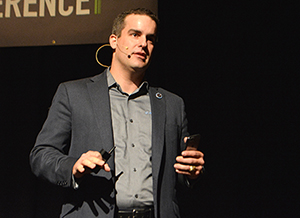
James Benham, JB Knowledge, spoke at the Transportation Conference about future technology and how it effects transportation. Photo by Rich Kemp |
When it comes to creating the transportation system of the future, MnDOT is already doing its research and laying the groundwork for great things to come.
Last month at Minnesota’s Transportation Conference, a keynote session by JB Knowledge CEO James Benham titled “Future Forecast: How Drones, Sensors, and Integrated Apps are Rewriting the Rules” inspired many people in the room.
Among the topics Benham cited in his talk were the Internet of Transportation, unmanned aerial vehicles (drones) and 3-D printing, which MnDOT is already studying or even using.
Internet of Transportation
In January, MnDOT Research Services published a report titled “The Transportation Futures Project: Planning for Technology Change.”
That study aimed to identify technological trends and their potential impacts on transportation infrastructure in Minnesota. The report details how the transportation system can accommodate such imminent innovations such as autonomous vehicles, mobile web services, mobility as a service, information and communication advances, infrastructure sensors and energy and fuel alternatives.
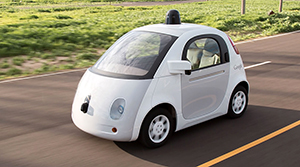
Google is one of many companies developing autonomous vehicle technology that researchers believe will make driving nearly extinct by 2040. Photo courtesy of Google |
For example, researchers predict that driving faces near-extinction by 2040, when non-autonomous vehicles will no longer be allowed on public roads at most times. As a result, total transportation-related fatalities may drop 90 percent, road geometry, sightlines and other design priorities may shift, and capacity and speed limits will likely increase on most major roadways.
Unmanned Aerial Vehicles (Drones)
When it comes to drones, MnDOT is already conducting important research that the rest of the nation is closely following. Tara Kalar and Jennifer Zink from MnDOT, and Barritt Lovelace of Collins Engineers, spoke about their efforts at last month’s conference.
Last year, MnDOT Research Services published a report titled “Unmanned Aerial Vehicle (UAV) Bridge Inspection Demonstration Project” that detailed how MnDOT could use drones to perform bridge inspection functions. The initial research project tested one drone’s capability in a variety of bridge inspection scenarios last summer at four Minnesota bridges.
In November, researchers conducted a second research phase to test another drone at the Blatnik Bridge in Duluth that coincided with that bridge’s regularly scheduled inspection.
A few weeks ago, researchers secured funding to conduct a research implementation project that aims “to implement a statewide UAS (unmanned aircraft systems) bridge inspection contract, which will identify overall cost effectiveness, improvements in quality and safety, and future funding sources for both state and local bridges,” according to the project proposal.
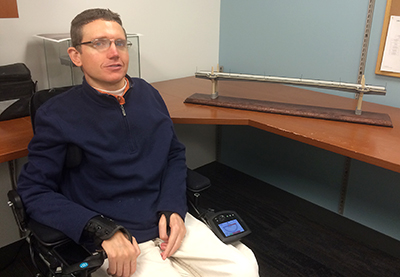
Chad Hanson, District 6 engineer, used 3-D-printing to create a model of the Red Wing Bridge that was used during the projectís public engagement events. Photo by Mike Dougherty |
3-D Printing
Benham’s talk also addressed 3-D printing, which Chad Hanson, a District 6 project manager, has already used successfully.
Hanson spoke at the conference about his experience using 3-D printing to create a model of the Red Wing Bridge project that brought the project idea to life. According to Hanson, the model enhanced public engagement and informed preliminary design efforts for the bridge.
Partners, stakeholders and members of the public could see, touch and hold the 3-D printed models, which accentuated the project’s engagement process. |
 |
|

|
 |
TABLE of CONTENTS
 |
Other states join with MnDOT to govern, fund next major road research effort |
By Shannon Fiecke, Research Services

Shongtao Dai, MnDOT Office of Materials and Road Research, shares results of recent research at a poster session during the NRRA Pavement Conference. More photos from the conference are at mndot.gov/mnroad/nrra/pavementconference. Photo by Shannon Fiecke |
After two decades of groundbreaking road research that has made Minnesota roads last longer, perform better and cost less, other states are joining the effort to help MnDOT plan the next phase of research at MnROAD, the state’s cold weather pavement test track.
MnDOT recently formed the National Road Research Alliance, a pooled fund, to finance and guide construction of MnROAD’s new test sections in 2017. Commitments have come from Wisconsin, Michigan, Illinois, Missouri, and Minnesota’s cities and counties (through the Minnesota Local Road Research Board), with academic and industry partnerships also forming.
MnROAD has 50 unique pavement test sections on Interstate 94 and a closed low-volume road near Albertville. In operation since 1994, the facility collects data that improves pavement construction, design and maintenance, saving Minnesota hundreds of millions of dollars from the first two phases of research.
The goal of the NRRA is to help agencies nationwide reap similar benefits as Minnesota from real-world road research, including issues related to cold climates, and to provide industry and academia a testbed for evaluating cutting edge pavement technologies.
“We want to do research that can be used by a wide range of customers throughout the world,” said Glenn Engstrom, Office of Materials and Road Research director and NRRA executive chair. “Partnerships will be essential for determining MnROAD research needs, direction and funding for the future.”
Benefits of Road Research
MnROAD, the state’s outdoor pavement research facility, is estimated to have produced the following quantifiable savings for Minnesota:
• Phase I (1994- 2006): $33 million per year
• Phase II (2007-2015): $10.3 million per year
• Phase Ill (2016-20XX): Similar benefits expected |
MnROAD’s first phase of research focused on concrete and asphalt structural designs, including spring and winter load restrictions, mechanistic-empirical pavement design and low-temperature cracking. Implementation of these results provided an estimated $33 million in annual savings in Minnesota, and up to $749 million nationwide.
In Phase II research, conducted from 2007 to 2016, more than 20 projects addressed asphalt and concrete construction, pervious pavements, maintenance, full-depth reclamation, recycled materials and the impacts of heavy farm equipment on pavements. A conservative estimate of cost savings from this last phase of research for Minnesota alone is $104 million over the next 10 years.
Led by an executive committee of state DOT members, the NRRA will plan and oversee the entire life cycle of the next phase of MnROAD research, from the selection of research topics to communication and implementation of the results. Member states will participate financially in the pooled fund, taking advantage of matching funds from Minnesota.
The NRRA replaces a collaborative organization called the Transportation Engineering and Road Research Alliance or TERRA, which ended in June 2015. The NRRA pooled fund was established to build a more robust road research and implementation program.
|
 |
|

|
 |
TABLE of CONTENTS
 |
Scholarship fund honors former pavement engineer, researcher Gene Skok |
By Shannon Fiecke, Research Services
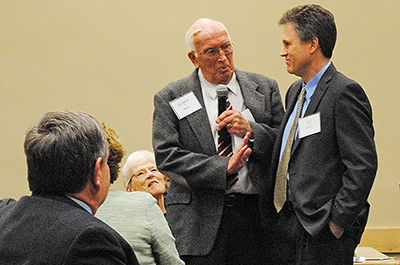
Gene Skok (center) mentored many of todayís pavement engineers, including Ben Worel, MnROAD operations engineer (pictured at right) and helped guide the formation of MnROAD, the stateís pavement test track. Photo by Cassandra Petersen |
Gene Skok, whose pioneering research led to the development of Minnesota’s asphalt pavement design procedure, was honored for his lifelong achievements with a scholarship fund named in his honor at February’s National Road Research Alliance Pavement Conference in St. Paul.
“Gene, in 1973, was ahead of his time in developing a pavement rating system, a precursor to the pavement management systems we now use,” said David Newcomb, senior research engineer, Texas A&M University, at the MnDOT-led conference. “His technical innovations were timely and timeless.”
Skok studied and later taught civil engineering at the University of Minnesota. He was one of the first researchers to turn the results of the original American Association of State Highway and Transportation Officials Road Test into a usable, flexible pavement design. He also provided valuable guidance in the development of MnROAD, the state’s pavement testing facility.
Skok’s career spanned more than 50 years. During that time, he worked with several companies and organizations, including MnDOT, the Asphalt Institute, Midwest Pavement Technologies (which he founded), Braun Intertec and the Minnesota Asphalt Pavement Association.
To pavement professionals around the world, Skok is best known for his contributions to the Association of Asphalt Paving Technologists, where he was secretary-treasurer for more than 40 years, ensuring that the work of hundreds of researchers was disseminated to thousands of practitioners, Newcomb said.
Skok’s approachability and willingness to invest time with others made him a great mentor to young pavement engineers and a model for established professionals.
MnROAD Operations Engineer Ben Worel recounted how he got his first job from Skok and traveled with him around Minnesota as a young engineer. Skok continued to advise Worel throughout his career.
His mentorship also changed the life and career of Ann Johnson, president of the Professional Engineering Services. Johnson now teaches civil engineering at the University of Minnesota.
“Taking one class in pavement engineering did not convince me to change my major, but Gene Skok did,” Johnson said.
|
 |
|

|
 |
TABLE of CONTENTS
 |
Minnesota GoMobile serves as outreach vehicle for community events |
By Rich Kemp
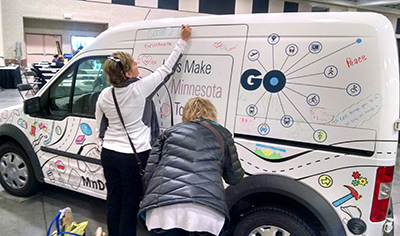
Community members color on the Minnesota GOMobile during an event in St. Cloud.Photo by Josh Pearson |
As the weather gets nicer and there are more opportunities for outdoor activities and events with agency customers across the state, the Office of Public Engagement and Constituent Services wants to remind all MnDOT staff about the Minnesota GoMobile.
Launched in 2015, the GoMobile is an innovative vehicle within the MnDOT fleet designed to serve as an outreach vehicle (literally and figuratively) that will allow the agency to better meet people where they are by providing a place for informal interaction.
“By ‘meeting people where they’re at,’ MnDOT can engage with a broader range of community members, including those under-represented at traditional open houses and public meetings,” said Jeanne Aamodt, customer relations manager. “When the van is daylighting as an interoffice mail delivery vehicle (its primary purpose), it serves as a moving billboard to spark interest in how transportation supports Minnesota’s quality of life.
The GoMobile will:
- Be used by district and CO planners, project managers, and others to conduct community engagement activities
- Provide a fun draw for community members because people can color on the van using special markers
- Be easily identifiable while on the road or at community events
- Be used initially by planners conducting public engagement for MnSHIP and SMTP updates
- Still be used for mail delivery during daytime hours
Directions for reserving the van:
- Find the *DOT_MinnesotaGoMobile in the address book
- Create a new meeting request
- Invite *DOT_MinnesotaGoMobile
- Check the calendar to determine the MGM’s availability (the meeting will be automatically accepted so it is up to employees to ensure it’s available)
- Send the meeting invitation for date and time
The decorated vehicle is designed to serve as a moving billboard to create interest in transportation’s support for communities, the economy and the environment. Previous engagement efforts showed that a child-friendly experience helps bring parents into the transportation discussion. That’s why the GO Mobile was designed to be interactive in nature, featuring an exterior design with array of black and white line drawings of the many connections transportation provides. Washable markers are available at pop-up events for children to color in the pictures.
The van will come equipped with the following items:
- Portable white board and markers – to post the (prepared) engagement questions
- Chalk markers and dry erase markers – for children to use on the van itself. Markers should be collected from the children as they leave the van.
- Portable table, tablecloth and two chairs to place next to the van, where appropriate
- First Aid Kit
- Handouts explaining the purpose of the van to encourage visitors and conversation – both adult and kid-focused (ice scrapers, coloring books, keychain flashlights, highway and bike maps, etc.)
- Basket for markers
For more information on the van, contact Sarah Rudolf at 651-366-3177. |
 |
|

|
 |
TABLE of CONTENTS
 |
Regional TZD workshops work to reduce traffic-related deaths |

Graphic shows the number of roadway fatalities from 1995 through 2015. |
Traffic safety advocates across the state will discuss Toward Zero Deaths goals, best practices and successes during eight spring TZD regional workshops. Each district hosts a workshop, which are designed to help implement TZD in local communities.
The “4-E” partners, and others interested in traffic safety, will hear about effective methods to reduce serious injuries and roadway deaths, whether it is through education, engineering, enforcement or emergency medical and trauma services.
“We saw an increase in traffic-related deaths last year,” says Kristine Hernandez, TZD program coordinator. “But that shouldn’t be discouraging, since we saw a record reduction in those types of crashes the year before. We need to stay the course and keep striving to think of ways to reduce any barriers our partners may have and fill the gaps in areas that don’t have services that are needed.”
Preliminary deaths and serious injuries experienced more than a 12 percent increase. Every crash category was higher in 2015 – including pedestrian crashes, bicycle crashes and motorcycle crashes. In many categories, the numbers of deaths more than doubled.
This is especially tough news after an encouraging 2014, where deaths and serious injuries were at their lowest since World War II. However, this is why, now more than ever, it is important to continue efforts to drive traffic-related deaths down to zero, Hernandez said.
“We are a data driven program, so we focus our efforts on where the data tells us to go. But using innovative methods, in addition to proven best practices, will help us continue to further reduce deaths on our roadways,” she said.
Minnesota’s TZD trend line of fatalities continues to move in a downward fashion, even though the line may fluctuate from year-to-year. Last year happened to be a year where the trend line spiked up, Hernandez said.
2016 TZD Regional Workshops:
- Metro: April 13 in Oakdale
- Southwest: April 22 in Morton
- South Central: April 26 in Mankato
- Southeast: May 5 in Rochester
- West Central: May 9 in Ottertail
- East Central: May 16 in St. Cloud
- Northwest: May 25 in Bemidji
- Northeast: June 16 in Duluth
Employees may register for their regional workshop at www.minnesotatzd.org/events/workshops/
The statewide conference will be Nov. 16-17 in Duluth. |
 |
|

|
 |
TABLE of CONTENTS
 |
Hwy 71 in District 2 receives Perpetual Pavement Award |
By Rich Kemp

Hwy 71 in District 2 received the Perpetual Pavement Award that recognizes long-lasting and high-quality asphalt pavements. Photo by TJ Melcher |
MnDOT received a Perpetual Pavement Award in March. Minnesota has had 14 pavements recognized with the Perpetual Pavement Award, more than any other state or agency.
The Asphalt Pavement Alliance presented eight state departments of transportation with its 2015 Perpetual Pavement Award that recognizes long-lasting and high-quality asphalt pavements. MnDOT received the award for Hwy 71 in Beltrami County from milepost 317.28 to 320.52.
“MnDOT is very proud to have received this Perpetual Pavement Award for Hwy 71 in District 2,” said Sue Mulvihill, deputy commissioner/chief engineer. “We take pride in our pavement management efforts and having a pavement that qualifies and lasts as a 'perpetual pavement' is an honor. We will continue to utilize the best information and research that we have to extend all of our pavement life cycles. This is a benefit to MnDOT and all of our roadway users.”
The Perpetual Pavement Award has been awarded to 108 pavements across the United States and Canada since its inception in 2001.
To qualify for the award, an asphalt pavement owned by a state DOT or local agency must be at least 35 years old and have a “proven high-quality structural design” that has not had a significant structural failure and has gone no less than 13 years on average between resurfacing. The pavement also must demonstrate “excellence in design, quality in construction and value to taxpayers.”
National Center for Asphalt Technology (NCAT) engineers evaluated the nominations for this year’s winners. |
 |
|

|
 |
TABLE of CONTENTS
 |
Whatís new on the web |
Updates to Right of Way Mapping and Monitoring website
The Right of Way Mapping and Monitoring website has a new look as a result of recent software changes implemented to keep pace with advancing technology. The website provides ready access to the highway right of way maps and other land management information for internal and external customers including the public. Various products used to support land management business needs are layered with MnDOT’s interactive Statewide Basemap Data. Users will find some of the operations much quicker than on the previous site.
The appearance has also been improved. Step by step help documentation is available and will soon be supplemented with short instructional videos currently under development by the LIS and Right of Way Mapping Unit in the Office of Land Management. For more information or support: 651-366-5000 or LISRWMAP.dot@state.mn.us. RWMM is available at: www.mndot.gov/maps/gisweb/row/
Art on Trunk Highway Right of Way
MnDOT will accept donations of art on trunk highway right of way in conformance with the new Art on Trunk Highway Right of Way policy. MnDOT will only consider proposals for art donations submitted by political subdivisions of the state, other state agencies or tribal governments. The policy provides details about:
- Eligibility requirements and application procedures
- Application review and approval process
- Written and approved agreement prior to art installation
- Art ownership and the Visual Artists Rights Act
- Responsibilities and contact information
The policy was approved April 2016. |
 |
|
| |
|



